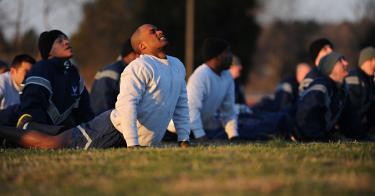Air Force standards for flight training and promotions have been on a downward spiral since the Cold War ended in 1991. Incredibly, the service’s senior leaders are about to accelerate that dive.
Before we explore these latest moves and their repercussions, let’s take a minute to revisit the journey that brought the Air Force to where it is today.
During the 1980s, the U.S. faced a potential conflict with the Soviet Union. Soviet air-to-air capabilities and surface-to-air missile systems presented a formidable threat. The U.S. Air Force, therefore, designed standards and a training pipeline that prepared pilots to excel in that environment. That pipeline incrementally stepped their skill levels by presenting an ever-growing number of tasks and increasingly complex systems and missions they were expected to master.
Training is expensive, but those costs rise steeply after flight school, making it the most economical point to screen out poor performers. Student failures at every level beyond becoming more and more burdensome; however, the costliest failures take place, not in training but in the unforgiving environment of combat. There, mission success and the lives of others rely on the faculties and the confidence of our pilots.
To ensure mission success, screening at all levels was intense. The washout rate for flight school in the 1980s was high—just three out of every four students got their wings. And the demand for proficiency elevated with every level of training beyond. A few more washed out of fighter lead-in training, front-line fighter training, and even Fighter Weapons School (Top Gun).
That began to change at the end of the Cold War. With the threat of a peer-level fight seemingly behind them, senior Air Force leaders began to relax service standards. Over time, their drive for efficiencies all but eliminated screening at every training level beyond flight school—and even there, things began to change.
Pilot training graduation rates rocketed up from 75 percent in the 1980s to 90 percent in the ‘90s.
From 2016 through 2019, that graduation rate averaged 96 percent, with several classes each year graduating everyone who entered. And that hefty four-percent washout rate included factors like a student's health issues as well as ethical and legal shortcomings.
Those eye-popping graduation rates came with no discernible improvement in candidate screening and no leap in the caliber of instruction. Meanwhile, the aircraft they were flying did not get any easier to fly.
Air Force screening through promotion has also plummeted. An officer’s chance of promotion to major was generally at or below 90 percent through 1997. Today, every eligible Air Force captain is promoted to Major, and it has been that way since 2017.
Graduation and promotion rates at or near 100 percent means either pre-entry screening is so thorough that everyone can meet a high standard or that standards have been lowered to the point where even the poorest performers graduate and advance.
Thankfully, the service’s pilot candidate selection method has remained relatively constant over the years. While most selection considerations revolve around physical standards, there are two additional factors that actually help sustain some modicum of quality for those who get their wings: a candidate’s college grade point average (GPA) and previous flying experience.
Academics are a big part of training. Those who struggle digesting system and procedural details have a hard time applying them in the air. On top of that, the academic demands of flight school are relatively easy compared to the operational systems and procedures they will encounter beyond flight school.
Previous flying experience matters as well. A previously demonstrated aptitude for flying almost inevitably translates into elevated performance at flight school.
But now, the service is about to remove both those factors from its flight school candidate screening process because it wants to increase the diversity of its rated force.
To prove that those moves would not reduce standards, the Air Force commissioned a recent study on the issue.
Amazingly, the follow-on report showed no correlation between GPA and the potential for a student to graduate from flight school. Not excel at flight school—but just to graduate. With a near 100 percent graduation rate, did the Air Force really need a study to come to that conclusion?
>>> How the U.S. Navy and Air Force Faced a Fighter Plane Readiness Crisis
To compound the issue, those with previous flying experience are now seen as having an unfair advantage, so the Air Force is removing flight time as consideration for certain types of candidates.
They are removing those two elements that elevate the quality of its pilots from its selection process so that those who fight our next war will have a more acceptable appearance.
To date, the Air Force has gotten away with its plummeting standards because of the relatively low-level threats it has faced for the last 30 years. Unfortunately, the soon-to-be-deepened hole in competency will show itself in a near-peer combat environment—the potential for which grows with every passing year.
When that next real war comes, the cumulative impact of declining Air Force standards will prove fatal not just for those who were given their wings but for the combatants—and the innocents—who were relying on them to come through.
This piece originally appeared in RealClear Defense



